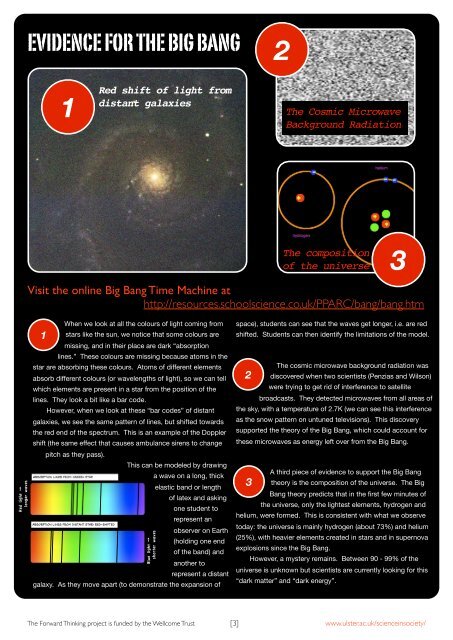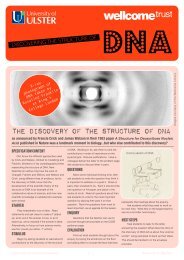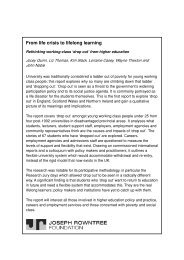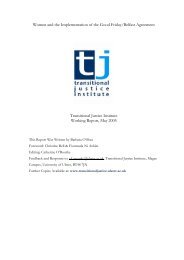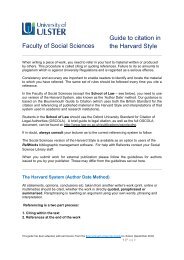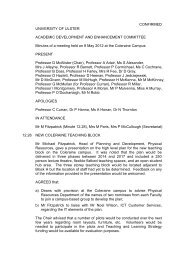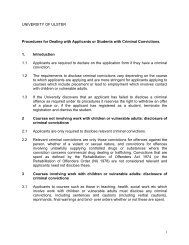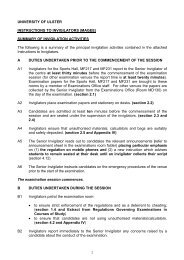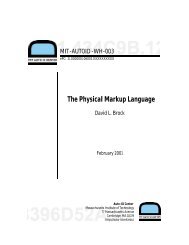It all started with the big bang - University of Ulster
It all started with the big bang - University of Ulster
It all started with the big bang - University of Ulster
You also want an ePaper? Increase the reach of your titles
YUMPU automatically turns print PDFs into web optimized ePapers that Google loves.
Red light ➙<br />
longer waves<br />
EVIDENCE FOR THE BIG BANG<br />
Visit <strong>the</strong> online Big Bang Time Machine at<br />
http://resources.schoolscience.co.uk/PPARC/<strong>bang</strong>/<strong>bang</strong>.htm<br />
1<br />
1<br />
When we look at <strong>all</strong> <strong>the</strong> colours <strong>of</strong> light coming from<br />
stars like <strong>the</strong> sun, we notice that some colours are<br />
missing, and in <strong>the</strong>ir place are dark “absorption<br />
lines.” These colours are missing because atoms in <strong>the</strong><br />
star are absorbing <strong>the</strong>se colours. Atoms <strong>of</strong> different elements<br />
absorb different colours (or wavelengths <strong>of</strong> light), so we can tell<br />
which elements are present in a star from <strong>the</strong> position <strong>of</strong> <strong>the</strong><br />
lines. They look a bit like a bar code.<br />
However, when we look at <strong>the</strong>se “bar codes” <strong>of</strong> distant<br />
galaxies, we see <strong>the</strong> same pattern <strong>of</strong> lines, but shifted towards<br />
<strong>the</strong> red end <strong>of</strong> <strong>the</strong> spectrum. This is an example <strong>of</strong> <strong>the</strong> Doppler<br />
shift (<strong>the</strong> same effect that causes ambulance sirens to change<br />
pitch as <strong>the</strong>y pass).<br />
absorption lines from distant star: red-shifted<br />
Red shift <strong>of</strong> light from<br />
distant galaxies<br />
This can be modeled by drawing<br />
Blue light ➙<br />
shorter waves<br />
a wave on a long, thick<br />
elastic band or length<br />
<strong>of</strong> latex and asking<br />
one student to<br />
represent an<br />
observer on Earth<br />
(holding one end<br />
<strong>of</strong> <strong>the</strong> band) and<br />
ano<strong>the</strong>r to<br />
represent a distant<br />
galaxy. As <strong>the</strong>y move apart (to demonstrate <strong>the</strong> expansion <strong>of</strong><br />
space), students can see that <strong>the</strong> waves get longer, i.e. are red<br />
shifted. Students can <strong>the</strong>n identify <strong>the</strong> limitations <strong>of</strong> <strong>the</strong> model.<br />
The cosmic microwave background radiation was<br />
discovered when two scientists (Penzias and Wilson)<br />
were trying to get rid <strong>of</strong> interference to satellite<br />
broadcasts. They detected microwaves from <strong>all</strong> areas <strong>of</strong><br />
<strong>the</strong> sky, <strong>with</strong> a temperature <strong>of</strong> 2.7K (we can see this interference<br />
as <strong>the</strong> snow pattern on untuned televisions). This discovery<br />
supported <strong>the</strong> <strong>the</strong>ory <strong>of</strong> <strong>the</strong> Big Bang, which could account for<br />
<strong>the</strong>se microwaves as energy left over from <strong>the</strong> Big Bang.<br />
A third piece <strong>of</strong> evidence to support <strong>the</strong> Big Bang<br />
<strong>the</strong>ory is <strong>the</strong> composition <strong>of</strong> <strong>the</strong> universe. The Big<br />
Bang <strong>the</strong>ory predicts that in <strong>the</strong> first few minutes <strong>of</strong><br />
<strong>the</strong> universe, only <strong>the</strong> lightest elements, hydrogen and<br />
helium, were formed. This is consistent <strong>with</strong> what we observe<br />
today: <strong>the</strong> universe is mainly hydrogen (about 73%) and helium<br />
(25%), <strong>with</strong> heavier elements created in stars and in supernova<br />
explosions since <strong>the</strong> Big Bang.<br />
However, a mystery remains. Between 90 - 99% <strong>of</strong> <strong>the</strong><br />
universe is unknown but scientists are currently looking for this<br />
“dark matter” and “dark energy”.<br />
The Forward Thinking project is funded by <strong>the</strong> Wellcome Trust [3] www.ulster.ac.uk/scienceinsociety/<br />
2<br />
3<br />
2<br />
The Cosmic Microwave<br />
Background Radiation<br />
The composition<br />
<strong>of</strong> <strong>the</strong> universe<br />
3


